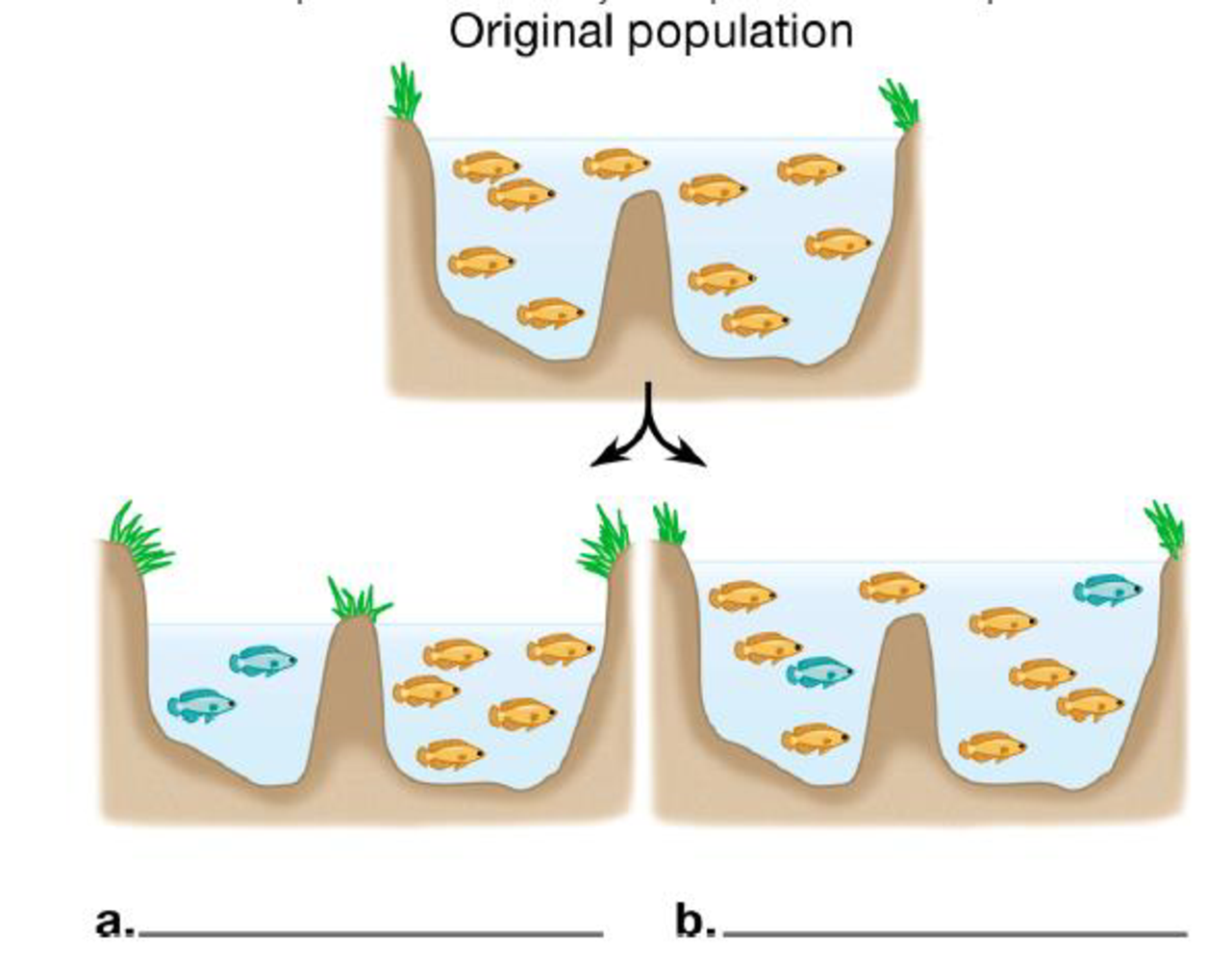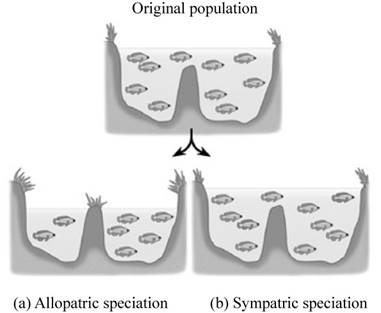
Concept explainers
Name the two types of

To name: Two types of speciation represented in the diagram and also to describe for each type in what way the reproductive barriers might have developed between the new species.
Concept introduction:
The speciation is an evolutionary process by which new species are formed. It can occur due to geographic, behavioral, anatomical and physiological factors.
The new species formed differ from their ancestors and cannot interbreed with their ancestral species to produce viable offspring.
Explanation of Solution
The type of speciation represented in the diagram (a) is allopatric speciation and in (b) is sympatric speciation.
The allopatric speciation occurs when two populations of a species are separated by a physical barrier such as a mountain or a hill. The gene flow between the two populations is stopped and over the time they become reproductively isolated due to natural selection, mutation or genetic drift.
In sympatric speciation, a new species arise from an ancestral species, while occupying the same geographical region. The two populations become reproductively isolated due to polyploidy, habitat differentiation and sexual selection.
Pictorial representation: Fig. 1 shows two types of speciation: (a) Allopatric speciation (b) Sympatric speciation.

Fig.1: (a) Allopatric speciation (b) Sympatric speciation.
Want to see more full solutions like this?
Chapter 14 Solutions
CAMP.BIO:CONC...MOD.MAST+PRINT>I<
- Not part of a graded assignment, from a past midtermarrow_forwardNoggin mutation: The mouse, one of the phenotypic consequences of Noggin mutationis mispatterning of the spinal cord, in the posterior region of the mouse embryo, suchthat in the hindlimb region the more ventral fates are lost, and the dorsal Pax3 domain isexpanded. (this experiment is not in the lectures).a. Hypothesis for why: What would be your hypothesis for why the ventral fatesare lost and dorsal fates expanded? Include in your answer the words notochord,BMP, SHH and either (or both of) surface ectoderm or lateral plate mesodermarrow_forwardNot part of a graded assignment, from a past midtermarrow_forward
- Explain in a flowcharts organazing the words down below: genetics Chromosomes Inheritance DNA & Genes Mutations Proteinsarrow_forwardplease helparrow_forwardWhat does the heavy dark line along collecting duct tell us about water reabsorption in this individual at this time? What does the heavy dark line along collecting duct tell us about ADH secretion in this individual at this time?arrow_forward
 Biology: The Dynamic Science (MindTap Course List)BiologyISBN:9781305389892Author:Peter J. Russell, Paul E. Hertz, Beverly McMillanPublisher:Cengage Learning
Biology: The Dynamic Science (MindTap Course List)BiologyISBN:9781305389892Author:Peter J. Russell, Paul E. Hertz, Beverly McMillanPublisher:Cengage Learning Biology (MindTap Course List)BiologyISBN:9781337392938Author:Eldra Solomon, Charles Martin, Diana W. Martin, Linda R. BergPublisher:Cengage Learning
Biology (MindTap Course List)BiologyISBN:9781337392938Author:Eldra Solomon, Charles Martin, Diana W. Martin, Linda R. BergPublisher:Cengage Learning Human Heredity: Principles and Issues (MindTap Co...BiologyISBN:9781305251052Author:Michael CummingsPublisher:Cengage Learning
Human Heredity: Principles and Issues (MindTap Co...BiologyISBN:9781305251052Author:Michael CummingsPublisher:Cengage Learning Biology Today and Tomorrow without Physiology (Mi...BiologyISBN:9781305117396Author:Cecie Starr, Christine Evers, Lisa StarrPublisher:Cengage Learning
Biology Today and Tomorrow without Physiology (Mi...BiologyISBN:9781305117396Author:Cecie Starr, Christine Evers, Lisa StarrPublisher:Cengage Learning
 Concepts of BiologyBiologyISBN:9781938168116Author:Samantha Fowler, Rebecca Roush, James WisePublisher:OpenStax College
Concepts of BiologyBiologyISBN:9781938168116Author:Samantha Fowler, Rebecca Roush, James WisePublisher:OpenStax College





